Family : Crocodylidae

Text © DrSc Giuliano Russini – Biologist Zoologist

English translation by Mario Beltramini
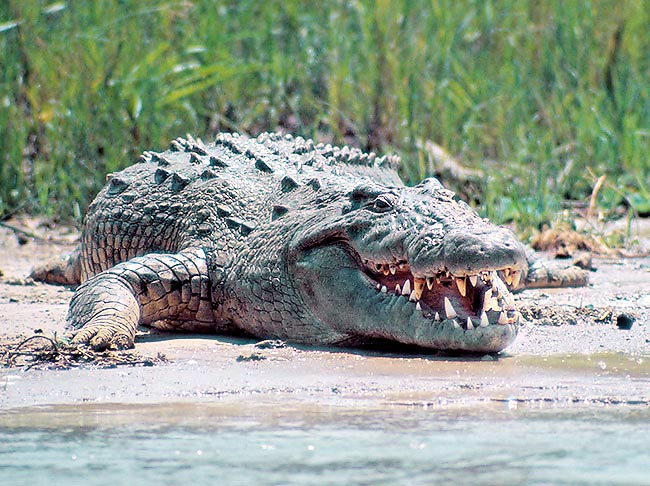
This Crocodylus niloticus on the Nile banks at Murchison Falls seems as coming from prehistory © Giuseppe Mazza
The Nile crocodile (Crocodylus niloticus) was discovered by the Austrian biologist Josephus Nicolaus Laurenti in 1768, during his scientific expeditions in Africa.
It is defined by the biologists an “apex-predator”, or “super-predator”, that is a dominant predator, that which, in Ecology is defined as a animal which, once reached the sexual maturity, is found at the top of the food chain and does not fear any other species, having no predators, a part a stronger or bigger congener.
It is an aquatic, carnivorous reptilian belonging to the ancient order of the Crocodiles (Crocodylia), by other taxonomical biologists indicated as Loricates (Loricata), family Crocodilids (Crocodylidae).
It is by far one of the strongest and most aggressive predating reptilians, in the specific of the African continent.
Among the “apex predators”, just for further clarifying its meaning, we find the lion, the tiger and the bear, for the placentate terrestrial quadrupeds, the killer whale, among the placentate aquatic mammals and the great white shark among the fishes. These animals are also defined in Ecology with the name of “tertiary consumers”, because they nourish only or almost totally of meat, whatever its provenience is, from an herbivore, “primary consumer”, or from other carnivores, insectivores or piscivores “secondary consumers”, that is, animals with a similar diet but lower in the food chain. We remind that in Biology, for “producers” we mean all the organisms afferent to the vegetable kingdom.
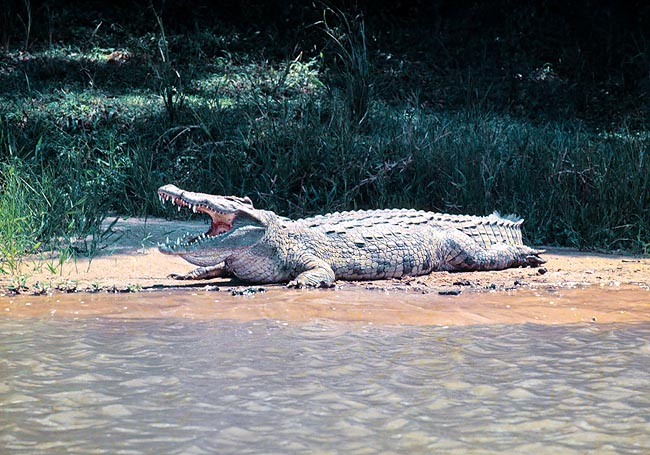
A big individual sleeping mouth wide open on the bank © Giuseppe Mazza
The natural history of the relationship between the crocodiles, the alligators, the gavials, the tomistomines (i.e. the false gavials) and the man is very old.
Even if nowadays, by means of his technology, with increasingly lethal and devastating weapons, the man is the true dominant predator (even if he is never cited as such), we have not to forget that since his first appearance on the Earth the Homo sapiens sapiens has been often prey of these reptilians and in particular in Africa, of the Crocodylus niloticus, which, among the all crocodiles is one of the most feared, aggressive and dangerous. By our times, the situation has drastically changed, and the crocodiles, exterminated by the man for alimentary purposes and the utilization of the skin in the leather goods industry, are running a serious risk of extinction.
Spread in the tropical fresh waters all over the planet, the crocodiles are found, at times, even in the sea, like, in Asia, the Saltwater crocodile (Crocodylus porosus), which lives mainly in the Pacific Ocean, even if going upstream for short distances in the rivers and staying often and willingly in the brackish coastal ponds.
The real and true crocodiles, compared to the alligators (afferent to the Alligatoridae) and the gavials (Gavialidae), have an ampler zoogeographic distribution. Furthermore, compared to the other two families, that of the Crocodylidae is the most numerous.
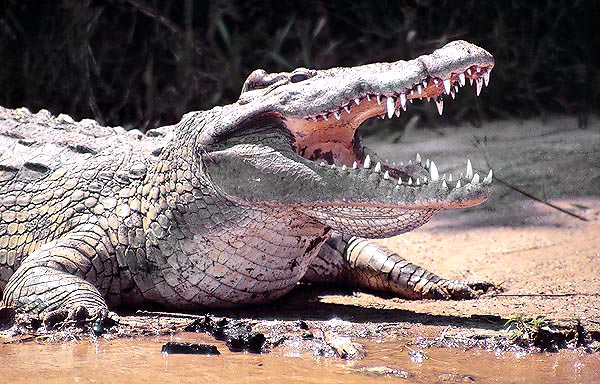
The Nile crocodile is a polyphyodont species. The fallen teeth are renewed at once © Giuseppe Mazza
Zoogeography
The Crocodylus niloticus, as the name suggests, lives per election in the waters and on the banks of the Nile.
Obviously, when we talk of the Nile, we talk about an almost 7.000 km long river, second only to the Amazon River, the longest river on the Earth.
Moreover, in the specific, the Nile is the fluvial resultant of two major tributaries: the White Nile, longer, and the Blue Nile, which furnishes the greatest quantity of water and of fertile silt.
The two sources originate in different geographic areas of the African continent: the Blue Nile from the vast lakes of central Africa and its waters, go up to Ruanda, north of Congo Brazzaville, touching also Tanzania, Kenya and then the Victoria Lake, whilst the second has its sources in the Lake Tana in Ethiopia.
The two tributaries meet in Sudan close to the capital Khartoum. Starting from its sources, the Nile goes through, for about 7.000 km, nations such as Ruanda, Burundi, Tanzania, Uganda, Sudan and Egypt, but the enormous dimension of its catchment basin is such that it allows this river to reach also regions such as the Democratic Republic of Congo, Kenya, Ethiopia and Eritrea. This geographic description is indispensable for understanding the vast distribution has met, during its natural history, the Crocodylus niloticus, which, rightly, occupies this biotope.
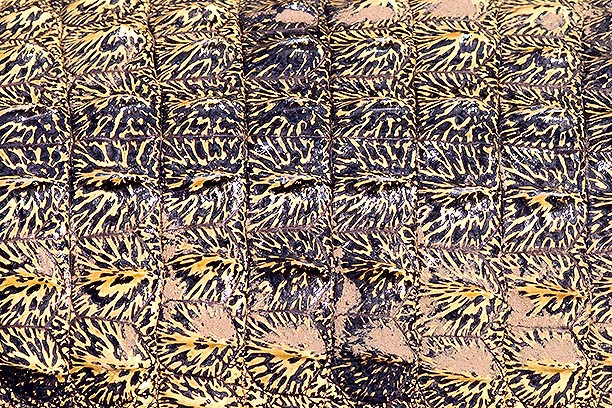
The back is covered by great horny scales supported by bony plates © Giuseppe Mazza
Once, it was possible to meet it in almost all Africa, nowadays it is confined in specific geographic areas, and has disappeared in the lower course of the Nile and in the most populated and urbanized areas. Its capacity of swimming also in the sea, even if lesser than that of the Crocodylus porosus, has allowed it to colonize also the Madagascar, where is still at home.
Habitat-Ecology
The Crocodylus niloticus usually fre- quents rivers and lakes, and relevant banks and beaches where the females lay the eggs and where often take place, besides, in the water, their ambushes. But, as briefly said before, the Nile crocodile may venture, for short distances, also in the sea. When in the fresh waters, it prefers the deep ones with weak current. During the warmest hours of the day, several individuals gather on the banks, where they stay some hours dozing and basking to the sun.
During these siestas, the Crocodylus niloticus is often cared, with mutual benefit, by the Glareolids (Glareolidae), a family of birds afferent to the order of the Charadriiforms (Charadriiformes), of the size of 20-25 cm, per a weight of 70-95 g and in particular by the Egyptian Plover (Pluvianus aegyptius). This nice small bird, about 20 cm long, has the back of ash grey colour, the lower parts white with a black collar, and the head also black, with a white band over the eyes.
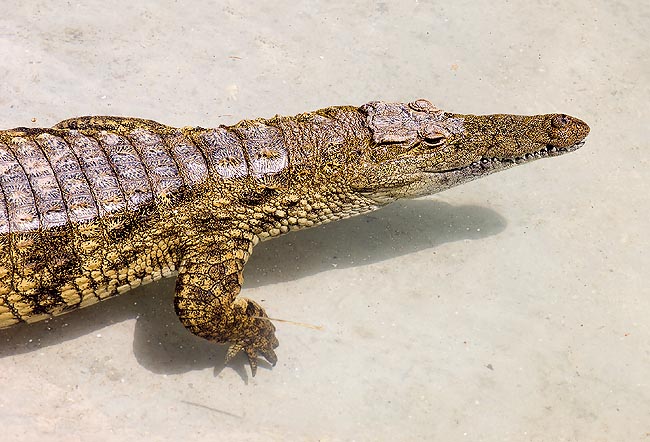
A Crocodylus niloticus in low water. The outline of the muzzle is unmistakable © Giuseppe Mazza
The wings, ashen above, are white below with black bands.
The Egyptian Plovers free these big reptilians from the numerous parasites, especially the leeches nesting in their armour, and even dare to insert their beak in the open fauces in order to pick up, between the sharp teeth, bits of residual food.
In reality, however, the name of “guardian” given also to them, is due to the fact that these birds, at the approaching of a man or of dangers of various type, such as, for instance, a Lion (Panthera leo), which is one of the few animals who has the courage to face the Crocodylus niloticus for stealing its prey, emit very sharp and insistent cries which induce their lazy hosts to plunge hastily into the water.
The individuals living along the coasts at times go into the sea, especially for avoiding the drought periods; whilst the “inland” ones face this serious cyclic nuisance, diving in the liquid mud, which covers them immediately with a protective crust and wait for the arrival of the rains in an almost “semi-lethargic” condition.
Morpho-physiology
It is one among the greatest crocodiles and reptilians of the planet, even if an Asian species and two American alligators are bigger.
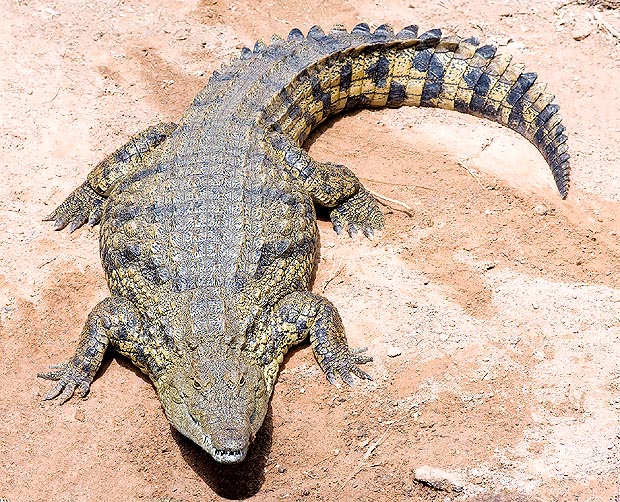
The caudal scales, much keeled, lead to think to the Mesozoic Era © Giuseppe Mazza
The average length of the adults slightly exceeds the 4 m, but some specimens, remarkably old, may get the total length (rostral apex-caudal apex) close to 7 m and the 1200 kg of weight. They may live from 70 to 100 years!
The Crocodylus niloticus has a relatively little sharp and moderately elongated muzzle. Thanks to this characteristic, it is easy to distinguish them from the only other African species, the proper Crocodile (Crocodylus cataphractus), who lacks, among other things, the longitudinal keels of scales on the muzzle.
The eyes are big and placed on the upper part of the head, in such a way to emerge at water level in order to observe, silently, while swimming.
The tail is long, composed of two rows of aculeate spikes (jagged ridges), and is extraordinarily robust. With it, it can hit the prey in order to stun it, and quite often it is capable to break the paws of a gazelle utilizing the tail as a whip.
The Nile crocodile has four very robust legs, which, contrary to what we might think, render it very fast and snappy even on the dry land. It has 22 conical teeth, per each side of the mandible and the jaw, and is a “polyphyodont” species, which means that it often loses the teeth and the same are immediately replaced as they grow again. The fourth tooth of the mandible is clearly more developed than the others, but usually also the seventh tooth of the upper jaw is no less. The fourth tooth is well visible in the crocodiles as it is placed in a recess of the jaw, whilst in the alligators the same is hidden in a gingival pouch.
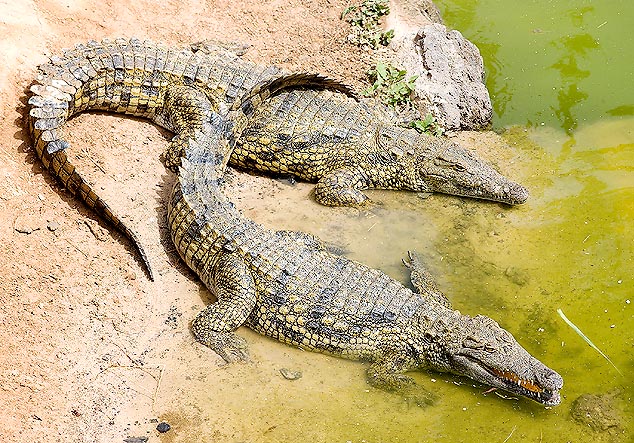
The Crocodylus niloticus is an apex predator fearing only its bigger conspecifics © Giuseppe Mazza
The skin covering is formed by great corneous scales, very robust especially on the back, keeled and supported by bony plates. Here, they are placed in several longitudinal series, whilst in the tail we may notice two converging lateral series which unite by the apical mid.
The scales supported by these caudal plates are strongly keeled, so much to form high and showy indented crests, which seem to be vestigial residues of the Mesozoic era, that of the dinosaurs.
The colour of the skin varies from the brown-dark green to the sand beige. We may see variously scattered, also big dark spots. In the newborn the livery tends to the yellow, dark green in some specimens. Adapted as they are to the aquatic life, the Nile crocodiles have a consequent breathing system.
The nares, placed on top of the muzzle, are formed by narrow slits which may be closed hermetically, whilst the ducts which connect them to the larynx, open behind a mobile part of the palate, which may be lowered, thus isolating the oral cavity from the respiratory system. This allows them to tear off (these animals do not chew), the flesh of the preys and swallow it while under water, once they have drowned the unlucky victim. Zebras, gnus, antelopes and gazelles are their choice food, but they nourish also of monkeys, aquatic birds (flamingos, gruiformes, waders, etc.), fishes (cichlids) and other reptilians. For what the hunting techniques are concerned, please refer to the introductory text of the Crocodylia. The lungs, exceptionally big, allow prolonged immersions.
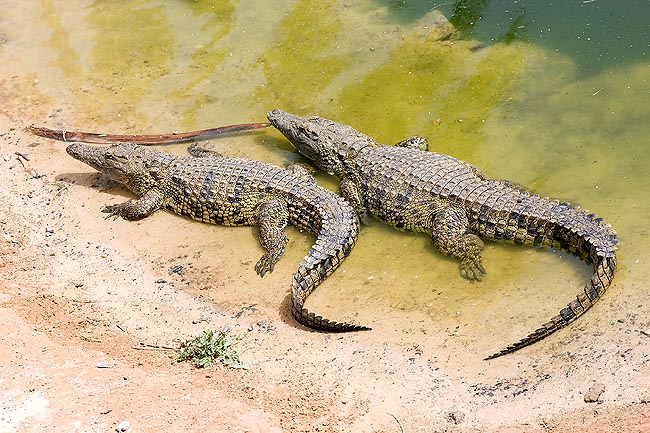
The females of Crocodylus niloticus bury the eggs in the banks sand, and always look at them © Giuseppe Mazza
The senses of hearing and sight are well developed. The auditory canal, which has no pinna, may also be hermetically closed. The eyes, with vertical pupil, placed up, almost dorsally on the head, allow seeing well under water and also in sub aerial environment, and are sensitive even to very small quantities of light, thus granting a perfect night vision.
Ethology-Reproductive Biology
The Crocodylus niloticus, like also the other crocodiles, alligators and gavials, is oviparous. The females lay from 30 to 100 eggs, of ellipsoidal shape, with a white pergameneous shell. Contrary, for instance, to the Alligators, they do not build up nests, even if rudimental, but bury the eggs in the sand of the banks of the rivers or the lakes where they do live. Even if it may seem, at first sight, that the female ignores the eggs during the period of the incubation (absence of parental cares), it is however sure that it does never lose sight of them, and by the time of the hatchling it acts for helping the small newborn, which, being interred, by means of chirping, draw the attention of the mother.
From this moment, for about four weeks, that is till their transfer in water, the young are protected from the attack of predators, greedy aquatic birds such as the big waders, for instance the Marabou stork (Leptoptilos crumeniferus), pythons, hyenas, leopards and monitor lizards, which are the only one able to find the buried eggs (please refer to the text on the Varanus niloticus ). The sex of the crocodiles is determined by the ambient temperature: if it is lower than 29° C, all the individuals will be females.
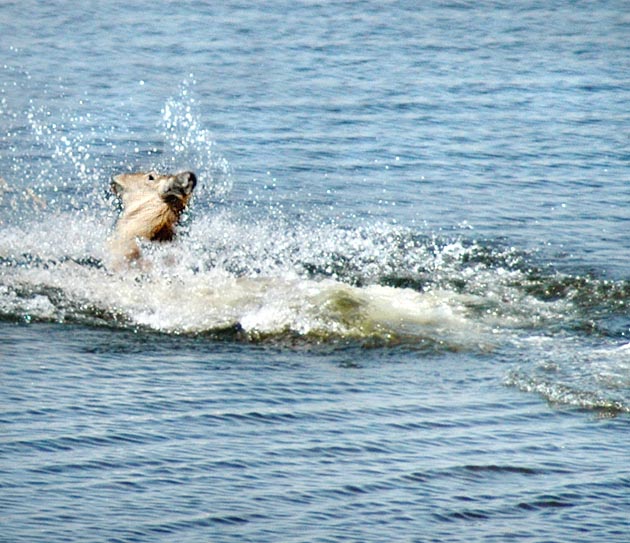
A kob dragged under water by a crocodile for drowning. It will be torn on the bottom © Gianni Olivo
During the dry season, the reproductive phase of the cycle with the couplings begins, and will end by the hatchling of the eggs in the wet season. The males are polygynous or polygamous, and this causes often the burst of furious fights for getting the partner. In any case, the reproductive seasons vary depending on the latitudes.
The sexual maturity takes place between the 7-10 years of age both for the males and the females, the gestation of the female lasts 90-100 days, and even a year of latency may pass between an egg deposition and the next one.
The Crocodylus niloticus, unluckily stands in the increasingly long red list of the endangered species. For this reason, the IUCN monitors its populations and often the biologists inside the natural reserves, where these animals are more and more confined, take the eggs for incubating them artificially, and getting the best reproductive yield, thus avoiding all the predation phenomena to which they are subject in the wild. Still nowadays, biologists and rangers struggle every day against the phenomena of poaching against these splendid reptilians, vestigial residues of the Secondary Era.
→ To appreciate the biodiversity within the CROCODYLIA and find other species please click here.
→ For general information about CROCODYLIA please click here.
